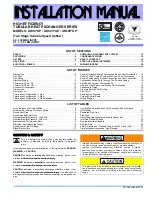
Page 14
3 -
For single appliance vents:
If the vertical vent or tile
lined chimney has a larger diameter or flow area than
the vent connector, use the
vertical vent diameter
to
determine the
minimum vent capacity
and the
vent
connector diameter
to determine the
maximum
vent capacity
. The flow area of the vertical vent, how
ever, shall not exceed 7 times the flow area of the
listed appliance categorized vent area, drafthood out
let area or flue collar area unless designed according
to approved engineering methods.
4 -
For multiple appliance vents:
The flow area of the larg
est section of vertical vent or chimney shall not exceed
7 times the smallest listed appliance categorized vent
area, drafthood outlet area or flue collar area unless
designed according to approved engineering meth
ods.
5 - The entire length of single wall metal vent connector
shall be readily accessible for inspection, cleaning,
and replacement.
6 - Single appliance venting configurations with zero lat
eral lengths, see tables 4 and 5, are assumed to have
no elbows in the vent system. For all other vent config
urations, the vent system is assumed to have two 90
elbows. For each additional 90
elbow or equivalent
(for example two 45
elbows equal one 90
elbow) be
yond two, the maximum capacity listed in the venting
table should be reduced by 10 percent (0.90 x maxi
mum listed capacity).
7 - The common venting tables 6, 7, 8, and 9 were gener
ated using a maximum horizontal vent connector
length of 1-1/2 feet (.46 m) for each inch (25 mm) of
connector diameter as follows:
TABLE 3
Connector
Diameter
inches (mm)
Maximum Horizontal
Connector Length
feet (m)
3 (76)
4-1/2 (1.37)
4 (102)
6 (1.83)
5 (127)
7-1/2 (2.29)
6 (152)
9 (2.74)
7 (178)
10-1/2 (3.20)
8 - If the common vertical vent is offset, the maximum
common vent capacity listed in the common venting
tables should be reduced by 20%, the equivalent of
two 90
elbows (0.80 x maximum common vent ca
pacity). The horizontal length of the offset shall not ex
ceed 11/2 feet (.46 m) for each inch (25 mm) of com
mon vent diameter.
9 - The vent pipe should be as short as possible with
the least number of elbows and angles required to
complete the job. The vent connector should be
routed to the vent using the shortest possible route.
10- A vent connector shall be supported without any dips
or sags and shall slope a minimum of 1/4 inch (6.4
mm) per linear foot (305 mm) of connector, back to
ward the appliance. See local and national installation
codes for support intervals and methods. National
installation code in the USA is current edition of Na
tional fuel Gas Code (ANSI-Z223.1). National installa
tion codes in Canada are current editions of CAN/
CGA-B149 codes.
11- Vent connectors shall be firmly attached to furnace
flue collars by screws or other approved means, ex
cept vent connectors of listed type B vent material
which shall be assembled according to the manufac
turer's instructions. Joints between sections of single
wall connector piping shall be fastened by screws or
other approved means.
12- When the vent connector used for Category I ap
pliances must be located in or pass through a crawl
space or other areas which may be cold, that portion of
the vent connector shall be constructed of listed
doublewall type B vent material or material having
equivalent insulation qualities.
13- All venting pipe passing through floors, walls, and ceil
ings must be installed with the listed clearance to com
bustible materials and be fire stopped according to lo
cal codes. In absence of local codes, refer to NFGC
(Z223.1).
14- No portion of the venting system can extend into, or pass
through any circulation air duct or plenum.
15- Vent connectors serving Category I appliances shall
not be connected to any portion of mechanical draft
systems operating under positive pressure such as
Category III or IV venting systems.
16- If vent connectors are combined prior to entering the
common vent, the maximum common vent capacity
listed in the common venting tables must be reduced by
10%, the equivalent of one 90
elbow (0.90 x maximum
common vent capacity).
17- The common vent diameter must always be at least as
large as the largest vent connector diameter.
18- In no case, shall the vent connector be sized more
than two consecutive table size diameters over the
size of the draft hood outlet or flue collar outlet.
19- Do not install a manual damper, barometric draft regu
lator or flue restrictor between the furnace and the
chimney.
20- When connecting this appliance to an existing dedicated
or common venting system, the venting system must be
inspected for signs of corrosion and general condition.
The sizing of the vent system must be reviewed and
must conform to these instructions and the provided
venting tables for the USA, and the appropriate venting
tables in the standards of CAN/CGA B149.1 and
B149.2 of the Natural Gas and Propane Installation
Code for Canada. If the existing system is in conflict with
these requirements, the venting system must be re
sized.















































